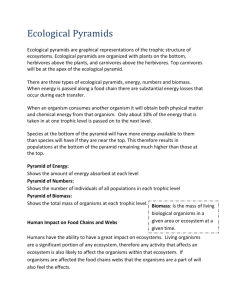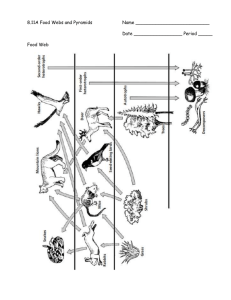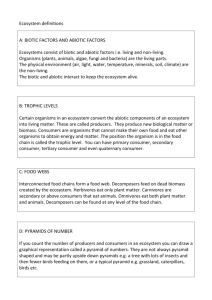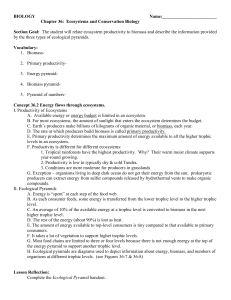Ecological Pyramids: Energy, Biomass, Numbers Worksheet
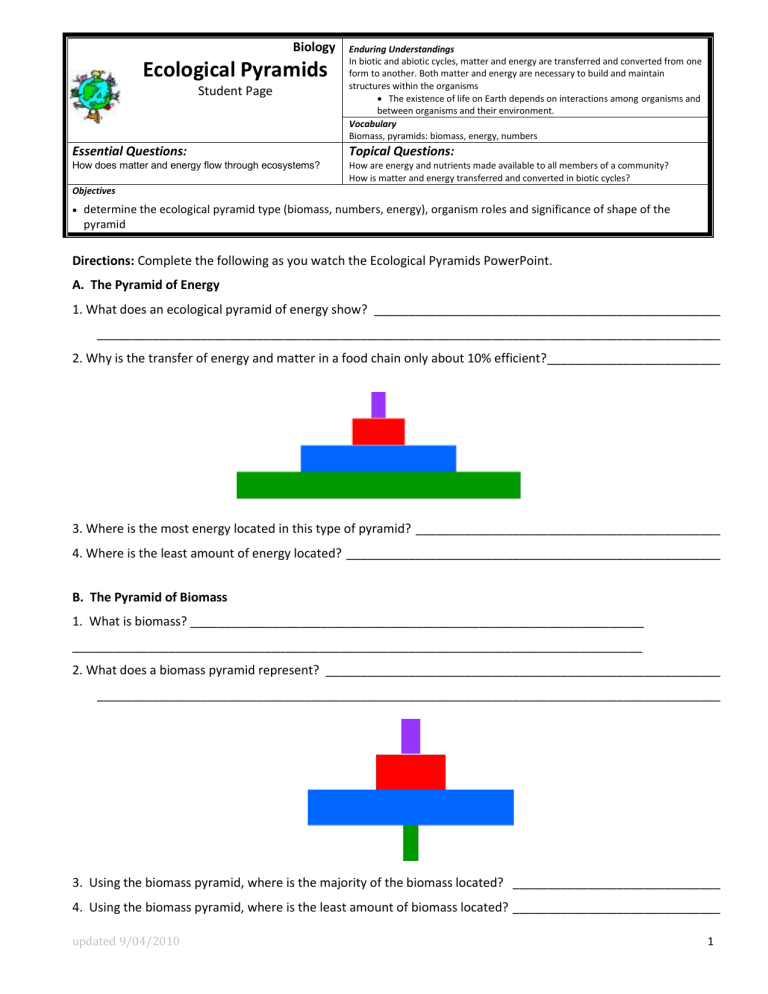
Biology
Enduring Understandings
In biotic and abiotic cycles, matter and energy are transferred and converted from one
Ecological Pyramids
form to another. Both matter and energy are necessary to build and maintain
Student Page structures within the organisms
The existence of life on Earth depends on interactions among organisms and between organisms and their environment.
Vocabulary
Biomass, pyramids: biomass, energy, numbers
Essential Questions:
How does matter and energy flow through ecosystems?
Topical Questions:
How are energy and nutrients made available to all members of a community?
How is matter and energy transferred and converted in biotic cycles?
Objectives
determine the ecological pyramid type (biomass, numbers, energy), organism roles and significance of shape of the pyramid
Directions: Complete the following as you watch the Ecological Pyramids PowerPoint.
A. The Pyramid of Energy
1. What does an ecological pyramid of energy show? __________________________________________________
__________________________________________________________________________________________
2. Why is the transfer of energy and matter in a food chain only about 10% efficient? _________________________
3. Where is the most energy located in this type of pyramid? ____________________________________________
4. Where is the least amount of energy located? ______________________________________________________
B. The Pyramid of Biomass
1. What is biomass? __________________________________________________________________
___________________________________________________________________________________
2. What does a biomass pyramid represent? _________________________________________________________
__________________________________________________________________________________________
3. Using the biomass pyramid, where is the majority of the biomass located? ______________________________
4. Using the biomass pyramid, where is the least amount of biomass located? ______________________________ updated 9/04/2010 1
5. Explain why the largest section is not at the bottom? _______________________________________
___________________________________________________________________________________
C. The Pyramid of Numbers
1. What does a pyramid of numbers represent? ______________________________________________________
__________________________________________________________________________________________
2. Using the numbers pyramid, where is the majority of the numbers located? _____________________________
3. Using the numbers pyramid, where is the least amount of numbers located? ____________________
4. Explain why the largest section is not at the bottom? _______________________________________
___________________________________________________________________________________
5. Pyramids Ecosystem A: Label the pyramids as Biomass, Numbers or Energy
Follows the normal pattern of having many more phytoplankton at TL1
The phytoplankton reproduce at a rate only just slightly higher than the rate at which they are eaten. Since they are so small and weigh so little there is a very small biomass. updated 9/04/2010
Follows the normal pattern of having much more energy available at TL1
2
6. Pyramids of Ecosystem B: Label the pyramids as Biomass, Numbers or Energy
Trees are huge but smaller in number compared to the grasses in a prairie and so are fewer compared to the number of organisms at the higher trophic levels.
Follows the normal pattern of having much more mass at TL1 from the huge trees.
Follows the normal pattern of having much more energy available at TL1
The diagrams below represent the amount of biomass and the number of organisms in the same ecosystem. Use these pyramids to answer questions 7 and 8.
3 rd Level Consumers
2 nd Level Consumers
1 st Level Consumers
Producers
Pyramid of Biomass
Pyramid of Numbers
7. What can you conclude about the ecosystem from the pyramid of numbers shown?
A.
There are more first-level consumers than producers.
B.
There are more third-level consumers than second-level consumers.
C.
There are more producers than first-level consumers.
D.
There are more second-level consumers than first-level consumers.
8. What can you conclude about the producers in the ecosystem based on the two pyramids shown?
A.
The producers in the ecosystem are probably very small organism.
B.
There are no producers in the ecosystem.
C.
The producers in the ecosystem are probably large organisms.
D.
Decomposers in the ecosystem outnumber the producers in the ecosystem. updated 9/04/2010 3

